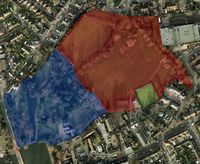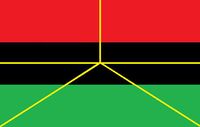Kingdom of the Grove
Kingdom of the Grove | |
|---|---|
|
Flag | |
 The Grove in blue, the rest of Orly in red, UK not highlighted | |
| Capital | N/A |
| Official languages | English |
| Demonym(s) | Grovian |
| Government | Absolute monarchy |
• King of the Grove | HM King Calum I |
| Establishment | 19 July 2010 |
The Kingdom of the Grove is a sovereign state within the nation of Orly. It borders the Kingdom of Copan, and is one of the Carshalton Nations.
History
The Kingdom of the Grove was a successor state of the Caesarship of Orly, created when Caesar Calum of Orly divided the Caesarship into two, creating the Kingdom of Copan and the Kingdom of the Grove.
The Grove was an absolute monarchy. At first, this was HI&RM King Calum I, but on 12 November 2010 he was deposed by the Western Emperor and replaced with Crown Prince Jonathan as Lord Regent. The Grove was allied with the neighbouring Kingdom of Copan, and with the Midget Nation-in-Exile.
On 8 December that same year, Jonathan abdicated. Declan I, the King of Copan, assumed the throne as Regent under the terms of the edict Caesar Calum had decreed when he divided Orly in two. The King then re-unified the two Kingdoms on that same day, founding the Tsardom of Orly and becoming Tsar.
Although the Grove was smaller than Copan, the King of the Grove held a small amount of power over Copan: had the office of Copanese Viceroy become vacant, the King of the Grove was permitted to select an Acting Viceroy until the King of Copan could appoint a new one.
The month after the Grove was reunified with Copan, Calum met with the Viceroy of Orly, Crown Prince Jonathan, and requested that he be reinstalled as King. With the approval of the Tsar, on 13 January 2011 the Viceroy declared Calum to once more be King, ruling over the Kingdom of the Grove as a subdivision of Orly, under the authority of the Viceroy and as a vassal to the Tsar. On 14 January the following year, Orly transitioned into a kingdom as it became a constituent country of the United Kingdom of New Wessex - the Grovian vassal monarchy was abolished, and Calum I was given the title Duke of the Grove.
Upon the Liberation of Orly on 24 June 2013, Calum I was re-appointed King by Emperor Jonathan I for a third reign. The Kingdom of the Grove once more became an independent sovereign state under the suzerainty of Austenasia.
Government
The Kingdom of the Grove is an absolute monarchy, ruled by King Calum I. The king holds absolute sovereign authority over the Grove (with the exception of the County of Memphis, where his decrees can be vetoed by the Countess).
Geography
The Grove comprises just under half of Orly. The first stage of the River Wandle passes through it, its main source being Carshalton Ponds, which border the Grove. Major geographical features include:
- Grove House, a large building constructed some time in the first half of the nineteenth century, is situated in the south of the Grove, to the south-west of the Play Area. It is used as offices by Sutton Council, who have so far issued no challenge to the King's sovereignty over the park. The Kingdom has so far not attempted to exercise authority over Grove House, in an effort to refrain from provoking a hostile backlash from the United Kingdom; the building is treated as a form of British embassy.
- Leoni Bridge is a white Portland stone bridge spanning the River Wandle at the extreme south of the Grove. It derives its name from the theory that it was designed by the Venetian architect Giacomo Leoni in the early 1700s, as it is known that he had been commissioned to design a new mansion nearby around that time, but there is no direct proof for this hypothesis.
- The Upper Mill is a disused watermill in the north of the Grove, alongside the River Wandle. It is likely that a watermill existed there since Anglo-Saxon times, but much of the modern structure is a recent restoration carried out after a fire in 2004.
- Esmond's Tree is a tree in Memphis which is near the Cascade. It is named after the former Emperor Esmond III of Austenasia, and is known for being sucessfully climbed by him numerous times.
- The Wisdom Tree was a tree which stood to the north-west of Grove House and was used as a frequent meeting place for Orlians before it was uprooted sometime between 4 June and 2 August 2010. The surrounding area is still referred to as Wisdom in reference to the now removed tree.
- The Play Area is a children's play area which borders Copan, situated to the east of Wisdom and the north-east of Grove House.
- The County of Memphis is an autonomous part of the Grove which is administered by its Countess, a position created on 26 September 2012. The County consists of:
- Memphis proper, the capital of the Grove and of Orly itself, and the most popular meeting place for Orlians.
- Ricecake Woods, a wooded area to the north of the Play Area.
- The Cascade (commonly known as the Waterfall) is a 1.5m high waterfall in the River Wandle in the north of the Grove, spanned by a nearby bridge. It has been ornamental in design since a reconstruction in the 1960s, its original purpose being to create a head of water to power the nearby Upper Mill.
- The Manky Pond, a stagnant area of water by the Upper Mill.
- An un-named field bordering the Wandle, just to the south of the Manky Pond.
